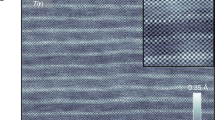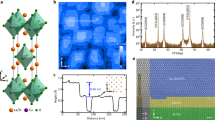Abstract
A complicating factor in unravelling the theory of high-temperature (high-Tc) superconductivity is the presence of a ‘pseudogap’ in the density of states, the origin of which has been debated since its discovery1. Some believe the pseudogap is a broken symmetry state distinct from superconductivity2,3,4, whereas others believe it arises from short-range correlations without symmetry breaking5,6. A number of broken symmetries have been imaged and identified with the pseudogap state7,8, but it remains crucial to disentangle any electronic symmetry breaking from the pre-existing structural symmetry of the crystal. We use scanning tunnelling microscopy to observe an orthorhombic structural distortion across the cuprate superconducting Bi2Sr2Can−1CunO2n+4+x (BSCCO) family tree, which breaks two-dimensional inversion symmetry in the surface BiO layer. Although this inversion-symmetry-breaking structure can impact electronic measurements, we show from its insensitivity to temperature, magnetic field and doping, that it cannot be the long-sought pseudogap state. To detect this picometre-scale variation in lattice structure, we have implemented a new algorithm that will serve as a powerful tool in the search for broken symmetry electronic states in cuprates, as well as in other materials.
This is a preview of subscription content, access via your institution
Access options
Subscribe to this journal
Receive 12 print issues and online access
$259.00 per year
only $21.58 per issue
Buy this article
- Purchase on Springer Link
- Instant access to full article PDF
Prices may be subject to local taxes which are calculated during checkout




Similar content being viewed by others
References
Timusk, T. & Statt, B. The pseudogap in high-temperature superconductors: An experimental survey. Rep. Prog. Phys. 62, 61–122 (1999).
Wise, W. D. et al. Charge-density-wave origin of cuprate checkerboard visualized by scanning tunnelling microscopy. Nature Phys. 4, 696–699 (2008).
Kondo, T., Khasanov, R., Takeuchi, T., Schmalian, J. & Kaminski, A. Competition between the pseudogap and superconductivity in the high-Tc copper oxides. Nature 457, 296–300 (2009).
He, R-H. et al. From a single-band metal to a high-temperature superconductor via two thermal phase transitions. Science 331, 1579–1583 (2011).
Kyung, B., Kancharla, S. S., Sénéchal, D. & Tremblay, A-M. S. Pseudogap induced by short-range spin correlations in a doped Mott insulator. Phys. Rev. B 73, 165114 (2006).
Phillips, P. Colloquium: Identifying the propagating charge modes in doped Mott insulators. Rev. Mod. Phys. 82, 1719–1742 (2010).
Lawler, M. J. et al. Intra-unit-cell electronic nematicity of the high-Tc copper-oxide pseudogap states. Nature 466, 347–351 (2010).
Hinton, J. P. et al. Point group sensitive probes of the pseudogap electronic structure in Bi2212. Bull. Am. Phys. Soc. 56, X25.005 (2011).
Li, J-X., Wu, C-Q. & Lee, D-H. Checkerboard charge density wave and pseudogap of high-Tc cuprate. Phys. Rev. B 74, 184515 (2006).
Zaanen, J. & Gunnarsson, O. Charged magnetic domain lines and the magnetism of high-Tc oxides. Phys. Rev. B 40, 7391–7394 (1989).
Kivelson, S. A., Fradkin, E. & Emery, V. J. Electronic liquid-crystal phases of a doped Mott insulator. Nature 393, 550–553 (1998).
Chakravarty, S., Laughlin, R., Morr, D. & Nayak, C. Hidden order in the cuprates. Phys. Rev. B 63, 094503 (2001).
Varma, C. M. Non-Fermi-liquid states and pairing instability of a general model of copper oxide metals. Phys. Rev. B 55, 14554–14580 (1997).
Subramanian, M. A. et al. A new high-temperature superconductor: Bi2Sr3−xCaxCu2O8+y . Science 239, 1015–1017 (1988).
Gladyshevskii, R., Musolino, N. & Flükiger, R. Structural origin of the low superconducting anisotropy of Bi1.7Pb0.4Sr2Ca0.9Cu2O8 crystals. Phys. Rev. B 70, 184522 (2004).
Kaminski, A. et al. Spontaneous breaking of time-reversal symmetry in the pseudogap state of a high-Tc superconductor. Nature 416, 610–613 (2002).
Hashimoto, M. et al. Particle–hole symmetry breaking in the pseudogap state of Bi2201. Nature Phys. 6, 414–418 (2010).
Hoffman, J. E. et al. A four unit cell periodic pattern of quasi-particle states surrounding vortex cores in Bi2Sr2CaCu2O8+δ . Science 295, 466–469 (2002).
Howald, C., Eisaki, H., Kaneko, N. & Kapitulnik, A. Coexistence of periodic modulation of quasiparticle states and superconductivity in Bi2Sr2CaCu2O8+δ . Proc. Natl Acad. Sci. USA 100, 9705–9709 (2003).
Vershinin, M. et al. Local ordering in the pseudogap state of the high-Tc superconductor Bi2Sr2CaCu2O8+δ . Science 303, 1995–1998 (2004).
McElroy, K. et al. Coincidence of checkerboard charge order and antinodal state decoherence in strongly underdoped superconducting Bi2Sr2CaCu2O8+δ . Phys. Rev. Lett. 94, 197005 (2005).
Wise, W. D. et al. Imaging nanoscale Fermi-surface variations in an inhomogeneous superconductor. Nature Phys. 5, 213–216 (2009).
Parker, C. V. et al. Fluctuating stripes at the onset of the pseudogap in the high-Tc superconductor Bi2Sr2CaCu2O8+x . Nature 468, 677–680 (2010).
Williams, T. L. Nanoscale Electronic Structure of Cuprate Superconductors Investigated with Scanning Tunneling Spectroscopy. PhD thesis, Harvard University (2011).
Lee, J. et al. Heavy d-electron quasiparticle interference and real-space electronic structure of Sr3Ru2O7 . Nature Phys. 5, 800–804 (2009).
Slezak, J. A. et al. Imaging the impact on cuprate superconductivity of varying the interatomic distances within individual crystal unit cells. Proc. Natl Acad. Sci. USA 105, 3203–3208 (2008).
Boyer, M. C. et al. Imaging the two gaps of the high-temperature superconductor Bi2Sr2CuO6+x . Nature Phys. 3, 802–806 (2007).
King, P. et al. Structural origin of apparent Fermi surface pockets in angle-resolved photoemission of Bi2Sr2−xLaxCuO6+δ . Phys. Rev. Lett. 106, 127005 (2011).
Hoffman, J. E. Spectroscopic scanning tunneling microscopy insights into Fe-based superconductors. Rep. Prog. Phys. 74, 124513 (2011).
He, X. et al. Nanoscale chemical phase separation in FeTe0.55Se0.45 as seen via scanning tunneling spectroscopy. Phys. Rev. B 83, 220502 (2011).
Presland, M., Tallon, J., Buckley, R., Liu, R. & Flower, N. General trends in oxygen stoichiometry effects on Tc in Bi and Tl superconductors. Physica C 176, 95–105 (1991).
Acknowledgements
We are grateful for fruitful conversations with E. Berg, A. Damascelli, J.C. Davis, S. Kivelson, D-H. Lee, F. Massee, J. Orenstein, S. Sachdev and C. Varma. This work is supported by the National Science Foundation (NSF), NSF Career, Presidential Early Career Award in Science and Engineering (PECASE) and Research Corporation. Work at Brookhaven National Laboratory is supported by the US Department of Energy. T.L.W. acknowledges support from a National Defense Science and Engineering Graduate fellowship.
Author information
Authors and Affiliations
Contributions
STM measurements were done by M.C.B., K.C., W.D.W., Y.Y., M.Z., T.L.W., E.J.M, A.P. and I.Z. Samples were grown by T.K., T.T., H.I., J.W., Z.X. and G.D.G. Data analysis was carried out by I.Z., E.J.M. and T.L.W., who also wrote the paper with E.W.H. and J.E.H.
Corresponding author
Ethics declarations
Competing interests
The authors declare no competing financial interests.
Supplementary information
Supplementary Information
Supplementary Information (PDF 635 kb)
Rights and permissions
About this article
Cite this article
Zeljkovic, I., Main, E., Williams, T. et al. Scanning tunnelling microscopy imaging of symmetry-breaking structural distortion in the bismuth-based cuprate superconductors. Nature Mater 11, 585–589 (2012). https://doi.org/10.1038/nmat3315
Received:
Accepted:
Published:
Issue Date:
DOI: https://doi.org/10.1038/nmat3315
This article is cited by
-
Low-energy gap emerging from confined nematic states in extremely underdoped cuprate superconductors
npj Quantum Materials (2023)
-
Doping induced Mott collapse and possible density wave instabilities in (Sr1−xLax)3Ir2O7
npj Quantum Materials (2019)
-
Electronic Structure of HgBa2CuO4+δ with Self-organized Interstitial Oxygen Wires in the Hg Spacer Planes
Journal of Superconductivity and Novel Magnetism (2018)
-
Local Noncentrosymmetric Structure of Bi2Sr2CaCu2O8+y by X-ray Magnetic Circular Dichroism at Cu K-Edge XANES
Journal of Superconductivity and Novel Magnetism (2018)
-
The study of electronic nematicity in an overdoped (Bi, Pb)2Sr2CuO6+δ superconductor using scanning tunneling spectroscopy
Scientific Reports (2017)



